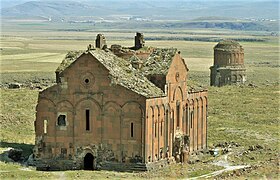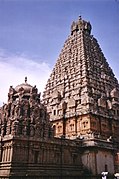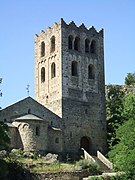
Gregory the Illuminator was the founder and first official head of the Armenian Apostolic Church. He converted Armenia from Zoroastrianism to Christianity in the early fourth century, making Armenia the first state to adopt Christianity as its official religion. He is venerated as a saint in the Armenian Apostolic Church and in some other churches.

The 11th century is the period from 1001 through 1100 (MC) in accordance with the Julian calendar, and the 1st century of the 2nd millennium.

Tuff is a type of rock made of volcanic ash ejected from a vent during a volcanic eruption. Following ejection and deposition, the ash is lithified into a solid rock. Rock that contains greater than 75% ash is considered tuff, while rock containing 25% to 75% ash is described as tuffaceous. Tuff composed of sandy volcanic material can be referred to as volcanic sandstone.

Shirak is a province of Armenia. It is located in the north-west of the country, bordering the provinces of Lori to the east and Aragatsotn to the south and southeast, and the countries of Turkey to the west and Georgia to the north. Its capital and largest city is Gyumri, which is the second largest city in Armenia. It is as much semi-desert as it is mountain meadow or high alpine. In the south, the high steppes merge into mountain terrain, being verdant green in the spring, with hues of reddish brown in the summer. The province is served by the Shirak International Airport of Gyumri.

Etchmiadzin Cathedral is the mother church of the Armenian Apostolic Church, located in the city dually known as Etchmiadzin (Ejmiatsin) and Vagharshapat, Armenia. It is usually considered the first cathedral built in ancient Armenia, and often regarded as the oldest cathedral in the world.

Gyumri is an urban municipal community and the second-largest city in Armenia, serving as the administrative center of Shirak Province in the northwestern part of the country. By the end of the 19th century, when the city was known as Alexandropol, it became the largest city of Russian-ruled Eastern Armenia with a population above that of Yerevan. The city became renowned as a cultural hub, while also carrying significance as a major center of Russian troops during Russo-Turkish wars of the 19th century.

Muş is a city in eastern Turkey. It is the seat of Muş Province and Muş District. Its population is 120,699 (2022). Almost all of its population consists of Kurds.

Aparan is a town in the Aparan Municipality of the Aragatsotn Province of Armenia, about 50 kilometers northwest of the capital Yerevan. As of the 2011 census, the population of the town was 6,451. As per the 2016 official estimate, Aparan had a population of around 5,300.

The Cathedral of Ani is the largest standing building in Ani, the capital city of medieval Bagratid Armenia, located in present-day eastern Turkey, on the border with modern Armenia. Its construction was completed in the early 11th century by the architect Trdat and it was the seat of the Catholicos, the head of the Armenian Apostolic Church, for nearly half a century.

Ani is a ruined medieval Armenian city now situated in Turkey's province of Kars, next to the closed border with Armenia.

Armenian architecture comprises architectural works with an aesthetic or historical connection to the Armenian people. It is difficult to situate this architectural style within precise geographical or chronological limits, but many of its monuments were created in the regions of historical Armenia, the Armenian Highlands. The greatest achievement of Armenian architecture is generally agreed to be its medieval churches and seventh century churches, though there are different opinions precisely in which respects.

Saint Emygdius was a Christian bishop who is venerated as a martyr. Tradition states that he was killed during the persecution of Diocletian.

Zvartnots Cathedral is a medieval Armenian cathedral near Vagharshapat (Ejmiatsin), Armenia. Built in the seventh century and now lying in ruins, Zvartnots was noted for its circular exterior structure, unique in medieval Armenian architecture, and a set of interior piers that upheld a multifloor structure crowned with a dome.

Martakert or Aghdara is a town in the Tartar District of Azerbaijan, in Nagorno-Karabakh. It was formerly controlled by the de facto breakaway Republic of Artsakh as the administrative capital of its Martakert Province before the 2023 Azerbaijani offensive. The town has an ethnic Armenian-majority population, and also had an Armenian majority in 1989. The town underwent heavy destruction by Azerbaijani forces while under their control during the First Nagorno-Karabakh War.
The 1679 Armenia earthquake took place on June 4 in the Yerevan region of Armenia, then part of the Safavid Iran.

Erivan Fortress or Yerevan Fortress was a 16th-century fortress in Yerevan.

Rafayel "Rafo" Israyelian was a Soviet Armenian architect.

The Ascoli Piceno Baptistery, also known as the baptistery of Saint John, is a religious building found on the eastern end of the piazza Arringo at the center of Ascoli Piceno and sitting next to and just north of the cathedral dedicated to St. Emygdius, the city's patron saint.




















